Books
Books

The Other Shore
When the dead begin speaking to sixteen-year-old Kim Nguyen, her peaceful childhood is over.
A delicate meditation on the nature of ghosts, belief, and how the future is shaped by the past. When the dead begin speaking to sixteen-year-old Kim Nguyen, her peaceful childhood is over. Suddenly everyone wants to exploit her new talent—her family, the Vietnamese government, and even the spirits themselves.
Hoa Pham is the author of several books and two plays. Her most recent publication is Empathy, also published by Goldsmiths Press under the Gold SF imprint. She is also the founder of Peril Magazine, an Asian-Australian online arts and culture magazine. Hoa lives in Melbourne, Australia.

The Original 1939 Notebook of a Return to the Native Land: Bilingual Edition
The first bilingual edition of this radically original work.
Aimé Césaire's masterpiece, Notebook of a Return to the Native Land, is a work of immense cultural significance and beauty. This long poem was the beginning of Césaire's quest for négritude, and it became an anthem of Blacks around the world. Commentary on Césaire's work has often focused on its Cold War and anticolonialist rhetoric—material that Césaire only added in 1956. The original 1939 version of the poem, given here in French, and in its first English translation, reveals a work that is both spiritual and cultural in structure, tone, and thrust. This Wesleyan edition includes the original illustrations by Wifredo Lam, and an introduction, notes, and chronology by A. James Arnold.

The Wounded Storyteller: Body, Illness, and Ethics
Since it was first published in 1995, The Wounded Storyteller has occupied a unique place in the body of work on illness. Both the collective portrait of a so-called “remission society” of those who suffer from some type of illness or disability and a cogent analysis of their stories within a larger framework of narrative theory, Arthur W. Frank’s book has reached a large and diverse readership including the ill, medical professionals, and scholars of literary theory.
Drawing on the work of authors such as Oliver Sacks, Anatole Broyard, Norman Cousins, and Audre Lorde, as well as from people he met during the years he spent among different illness groups, Frank recounts a stirring collection of illness stories, ranging from the well-known—Gilda Radner’s battle with ovarian cancer—to the private testimonials of people with cancer, chronic fatigue syndrome, and disabilities. Their stories are more than accounts of personal suffering: they abound with moral choices and point to a social ethic.
In this new edition Frank adds a preface describing the personal and cultural times when the first edition was written. His new afterword extends the book’s argument significantly, writing about storytelling and experience, other modes of illness narration, and a version of hope that is both realistic and aspirational. Reflecting on both his own life during the creation of the first edition and the conclusions of the book itself, Frank reminds us of the power of storytelling as way to understanding our own suffering.
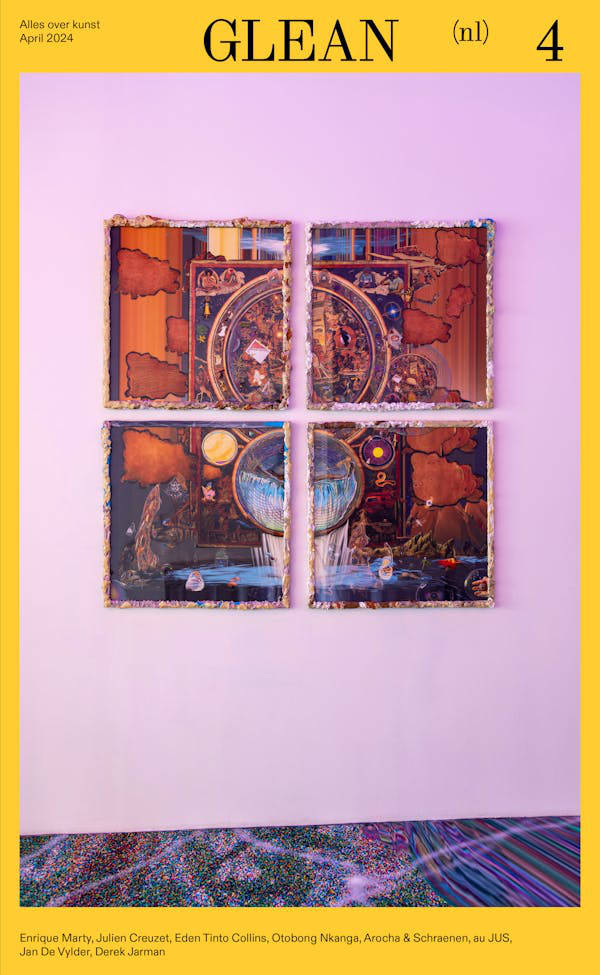
GLEAN - Issue 4 (NL edition)
Enrique Marty, Julien Creuzet, Eden Tinto Collins, Otobong Nkanga, Arocha & Schraenen, au JUS, Jan De Vylder, Derek Jarman

Pier Paolo Pasolini: Writing on Burning Paper
Annabel Brady-Brown, Giovanni Marchini Camia
Published on the centenary year of Pasolini’s birth, Pier Paolo Pasolini: Writing on Burning Paper is a dual edition that stages a dialogue between cinema today and Pasolini’s timeless films and words.
The two complementary volumes slide into one another, forming a unique set that evokes and celebrates Pasolini’s enduring influence. The smaller book features his epic autobiographical poem ‘Poet of the Ashes’, in a revised translation by esteemed poet Stephen Sartarelli; the larger book comprises original tributes by vital filmmakers from across the contemporary cinema landscape.
Twenty filmmakers shared personal reflections in the form of essays, poems, photographs, drawings and more: Catherine Breillat, Luise Donschen & Helena Wittmann, Jia Zhangke, Radu Jude, Payal Kapadia, Alexandre Koberidze, Dane Komljen, Mike Leigh, Mariano Llinás, Roberto Minervini, Valérie Massadian, Luc Moullet, Ben Rivers, Angela Schanelec, Ulrich Seidl, Basma al-Sharif, Deborah Stratman, Anocha Suwichakornpong and Gustavo Vinagre.
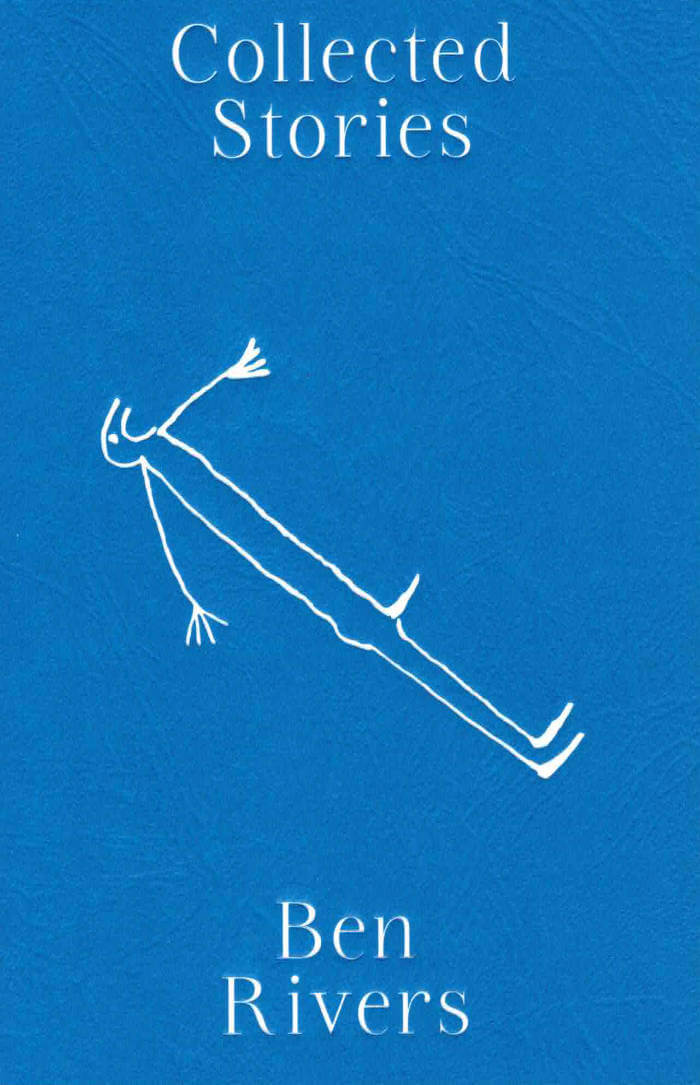
Ben Rivers: Collected Stories
Collected Stories is, as implied by the title, a collection of stories, curated by Ben Rivers. Fiction and poetry have always been an essential source of inspiration for his filmmaking. On the occasion of the retrospective Ghost Strata, and other stories, held at Jeu de Paume in Paris in November 2023, he decided to bring his films in conversation with writers who have influenced him over the years. Rivers invited fourteen authors to watch one of his films and respond in writing in any way they wished. Imaginative and surprising, the fables, essays and poems of Collected Stories come together in a beautiful celebration of the work of one of contemporary cinema’s vital artists, doubling as a testament to the reciprocal nature of inspiration.
The authors of these collected stories are Gina Apostol, Chloe Aridjis, Kevin Barry, Xiaolu Guo, Golan Haji, M John Harrison, Daisy Hildyard, Nathalie Léger, Vanessa Onwuemezi, Helen Oyeyemi, Iain Sinclair, Irene Solà, Lynne Tillman and Marina Warner.

Tale of cinema
In the fourth title of the acclaimed DecadentEditions series, Dennis Lim explores the oeuvre of South Korean auteur Hong Sangsoo via his 2005 film. Forty minutes in, we realise we’ve been watching a film within the film. The ‘real’ characters leave the cinema and find themselves reenacting what they just saw, as a chance encounter invites a suicide pact. Is it life imitating art, or the other way around? Dennis Lim is a film curator, teacher, and writer. He is currently the Artistic Director of the New York Film Festival.

Inland Empire
‘Inland Empire’ is a film by David Lynch about a once-feted Hollywood actress who is cast in a movie that is rumoured to be cursed. From a queer, feminist perspective, film critic Melissa Anderson examines how Lynch’s late masterpiece is not only a brilliant evocation of how images work on the mind, but how powerful “acteurs” are in the creation of dreamlike cinema. Laura Dern’s astonishing performance, as the film’s realities splinter and identities multiply, is elucidated by Anderson through her deep affection and respect for Lynch. The book is part of the Decadent Editions series, which examines one film for every year of the 2000s, each a milestone of contemporary cinema.

Ten Skies
Ten shots of the sky, each ten minutes long. That’s all it takes to describe James Benning’s film from 2004. And yet, this simplicity conceals a rich and absorbing drama, one of the great works of the American avant-garde. Scholar and critic Erika Balsom unfolds its hidden intricacies of meaning, extending its lessons with crystalline prose, a comparable sense of depths, and an exhilarating, maximalist intimation of what criticism can do and become. She brings you from the film itself into the mind of the artist, through philosophical musings and art historical scholarship. The book is part of a Decadent Editions series of 10 books about 10 films.

The Mollino Set
New York-based professor Lytle Shaw journeys to Italy in this adventurous exploration of the life and work of architect, designer, and photographer Carlo Mollino (1905–1973). In 1933 the young Mollino received a commission from Mussolini’s regime for his first building: an administrative centre in Piedmont. Later works include furniture and interior design, a book on photography, and an asymmetrical car that raced at Le Mans in 1955.
The book centres around Shaw’s realisation that this prolific talent’s conflicted legacy offers a unique window on the role that post-war Italian politics and culture played in the country’s reimagining of itself as a victim, rather than a proponent, of fascism.

Zoo Index - Reader (volume 1)
Zoo Index Reader examines the relevance and effect that zoos have in shaping our gaze towards non-human animals and by extension ourselves/each other.
Through a mixture of visual research into zoological space—in the form of an A-Z glossary—and written contributions on the history of menageries, the confinement and privatization of land, pets, zoo architecture, the "naturalization" of animals, and the role of zoos and animals in the history of cinema, among many other things, this first volume asks: Do we need zoos? What does a meaningful coexistence with animals look like? Why have we decided to give a balloon to an elephant?
With Terezie Štindlová, jacob lindgren, A+E Collective, Chanelle Adams, John Berger, Andrea Branzi, David Hancocks, Eliot Haworth, Institute for Postnatural Studies, Suzanne van der Lingen, Angelo Renna, Laurel Schwulst, Richard Weller.
Designed by Terezie Štindlová

Aube
Caroline Bachmann's dawn paintings.
Caroline Bachmann's paintings owe as much to turn-of-last-century Symbolism—in their attempt to depict an infinite stillness, whose synthetic depiction of nature could be mistaken for that of eternity—as to plein air painting. The artist lives and works on the shore of Lake Geneva, where she spends hours contemplating the scenery, recording with a lead pencil on paper minute details of atmospheric events, making notes in the margins of subtle colour changes—not unlike comic book colourists of the pre-digital age, whose job it was to pass on to engravers written codes corresponding to the 64 possible combinations of percentages of cyan, magenta, yellow and black at their disposal. Back in the studio, the paintings are then built up over a lengthy period of time with translucent glazes of oil paint.
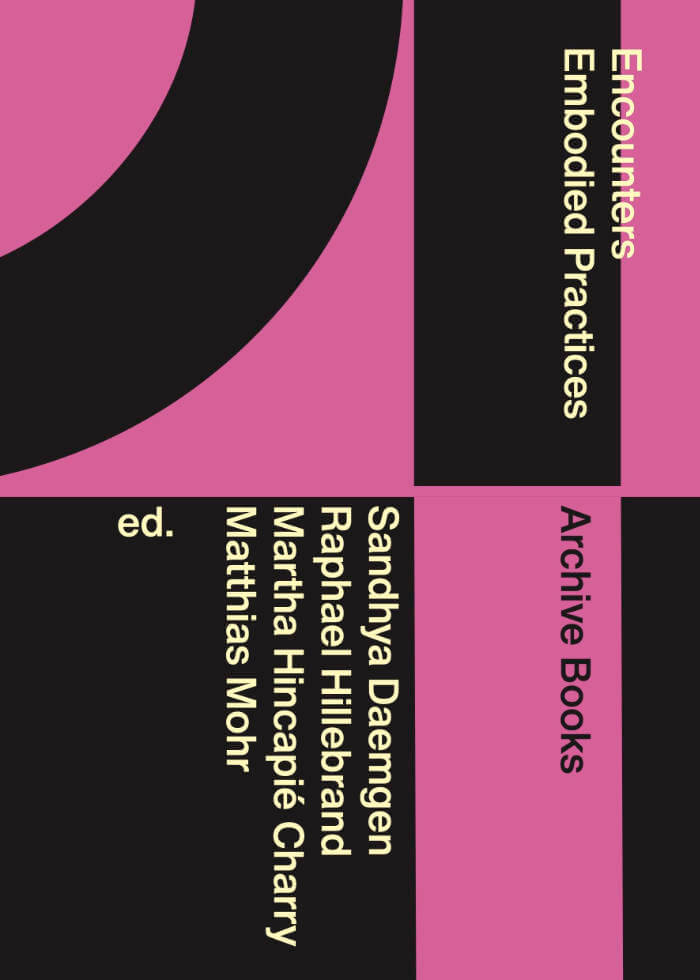
Encounters – Embodied Practices
Sandhya Daemgen, Raphael Hillebrandt and 2 more
Conversations about embodied strategies of knowledge production and knowledge transmission based on the choreographic and curatorial practices of about fifteen international choreographers, performers, dramaturges and curators.
In the context of the numerous ethical-political challenges of the global present, actors from the dance and choreography scene both in Berlin and internationally talk about forms of knowledge production beyond the prevailing conception found in Western modernity. They counter the mind-body separation and the notion of a universality of knowledge with multiplicities of knowledge production that emerge with and from the reality of differently situated bodies.
What potential do embodied practices offer for emancipatory movements? How can community be created through these practices, and what responsibilities does this entail? What role does the body play in the preservation and transmission of knowledge?
In this publication, edited by the choreographers and curators Martha Hincapié Charry, Sandhya Daemgen, Raphael Moussa Hillebrand and Matthias Mohr; Lukas Avendaño, Wagner Carvalho, Sandhya Daemgen, Ismail Fayed, Alex Hennig, Raphael Moussa Hillebrand, Martha Hincapié Charry, Isabel Lewis, Matthias Mohr, Prince Ofori, Mother "Leo" Saint Laurent, Léna Szirmay-Kalos, Thiago Granato and July Weber conduct conversations about embodied strategies of knowledge production and knowledge transmission based on their respective choreographic and curatorial practices.
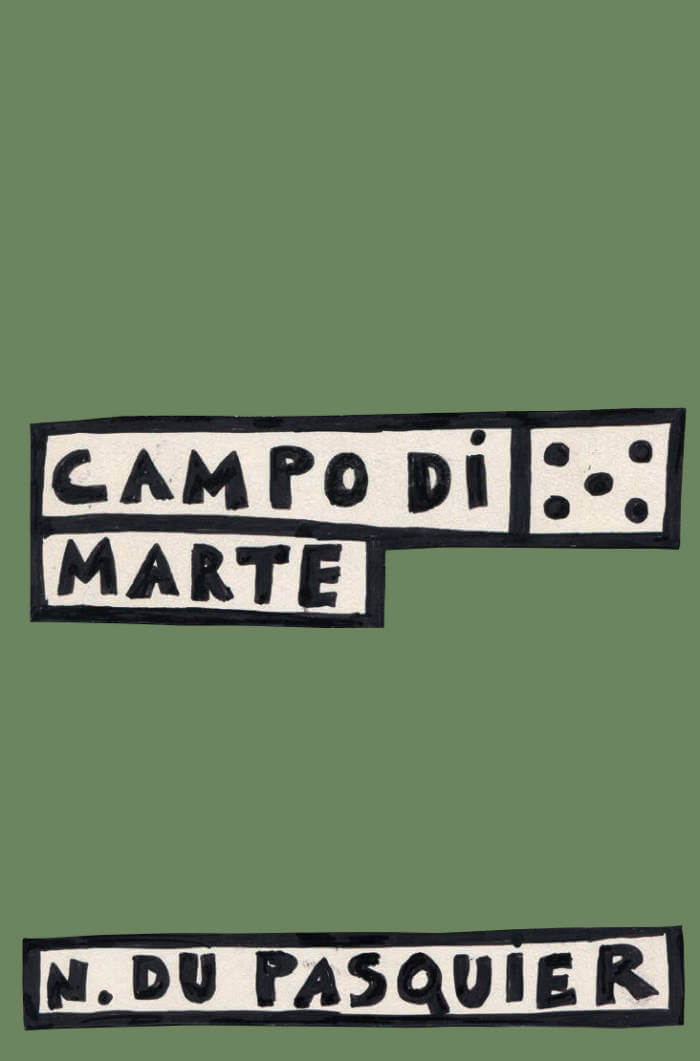
Campo di Marte
Campo di Marte was devised in March 2020, at a time when Nathalie Du Pasquier was not painting. After cutting out photos of paintings produced between the 1980s and 2020, the French artist then placed them in a sequence as if they were a series of typefaces, focusing solely on their formal qualities and the scope for interpretation offered by their assembly. What comes out is an enchanting game of nonsense, an everyday surrealism in which the images make up sentences of sorts, interwoven with various elements taken from the world of books: titles, poems or mere calculations – times when the artist was lost for words.
As Du Pasquier states: "The book was supposed to come out at the same time as the exhibition opening. That won't be the case, but it doesn't matter as they really are two separate things. This paperback is not a catalogue at all: it's something you can browse through even while sitting on the underground."

Pour des écoles d'art féministes !
Nelly Catheland, Adèle Bornais and 1 more
A collective manifesto for feminist art schools.
Bringing a series of intersectional feminist lectures, interviews, workshops and discussion groups back to an art school is crucial to sharing tools for emancipation and challenging the implicit criteria that structure our views and practices (identification with Western visual norms, romantic-capitalist representations of the artist-author, etc.). It is vital to give a voice to artists and those who support them in the ways in which they deal with, and even elude, relations of power.
The primary aim of this book is to share the content hosted and produced at the École Supérieure d'Art de Clermont Métropole between 2017 and 2022. It is also an opportunity to work with a group of students, artists and researchers, to think about how invitations and the production of the book can be drawn up collectively; it is a tool for collective and ideally horizontal pedagogical work within a hierarchical and hierarchizing institution. The invitations, transcription and editing of the texts were done jointly.
Edited by Lilith Bodineau, Adèle Bornais, Nelly Catheland, Charlotte Durand, Martha Fely, Lola Fontanié, Eulalie Gornes, Chloé Grard, Sophie Lapalu, Eden Lebegue, Michèle Martel, Sarah Netter, Clémentine Palluy, Mauve Perolari, Simon Pastoors, Rune Segaut, Danaé Seigneur.
Texts by Nino André & Vinciane Mandrin, Rachele Borghi, Tadeo Cervantes, Adiaratou Diarrassouba, Kaoutar Harchi, T*Félixe Kazi-Tani, Nassira Hedjerassi, Gærald Kurdian, H.Alix Sanyas, Sophie Orlando, Émilie Renard, Liv Schulman, Danaé Seigneur, Pau Simon.

Histoire de la séparation
Pour les révolutionnaires des deux derniers siècles, l’accumulation du capital devait unifier la classe ouvrière sous la bannière du sujet révolutionnaire. Le mouvement ainsi né était appelé à renverser la société de classes et les clivages divisant les prolétaires. Mais le mouvement de la valeur a finalement triomphé, pour donner naissance à la société de la séparation. L’atomisation a pris le pas sur les puissances du rassemblement. La civilisation du capital traverse aujourd’hui une crise sans fin, mais les forces capables de la défaire brillent par leur absence.
Ces textes tirés de la revue Endnotes, réunis pour la première fois en français, dessinent la carte d’un présent ponctué de paysages désindustrialisés, de centres logistiques et de bidonvilles où s’entassent les populations rejetées aux marges de l’accumulation – autant de coordonnées nécessaires pour continuer à penser le dépassement du capitalisme : une fois encore, reprendre le chantier de l’hypothèse communiste.
Endnotes est une revue théorique communiste produite par un groupe de discussion du même nom basé en Grande-Bretagne et aux États-Unis.
Traduction: Pablo Arnaud
Préface: Aaron Benanav Et John Clegg

Spatial Folders #1
This publication is the first issue of ‘Spatial Folders’, a thematic periodical that is produced by the faculty of Master Interior Architecture: Research and Design (MIARD) program at Piet Zwart Institute, Willem de Kooning Academy in Rotterdam. It is composed of a selection of graduation theses alongside contributions by guest authors that focus on urgent socio-cultural, socio-political, and ecological issues that affect the (built) environment and its representation regimes.
This first issue focuses on extraction and extractivism that characterises the power structures that make our worlds and their historicities. Across time extraction processes have been making and changing the spaces of the world through displacement of bodies and matter, from within and across the earth. At the same time, these processes establish epistemologies and forms of representation that articulate extraction as natural or inevitable within the frameworks of anthropocentrism, capitalism, colonialism, racism, or hetero-reproductivism.
This collection of texts approaches the question of extraction from a variety of spatial perspectives. The contributions zoom in to specific sites, cases, and areas of interest while providing a critical analysis of various networks of power and influence across time and space. These works do not turn away from the material aspect of extraction but rather closely trace the spatial and material conditions and consequences of extraction in the case of oil, hormones, milk, wood, and water, among others.
With Kris Dittel, Golnar Abbasi, Eva Garibaldi, Shiila Infriccioli, Natasha Marie Llorens, Jane Rendell, Shonali Shetty, Alex Augusto, Suárez Agnes Tatzber, Elien Vermoortel, Dominique Willis, Clementine Edwards, Zoraïma Hupkes
Design by Dongyoung Lee
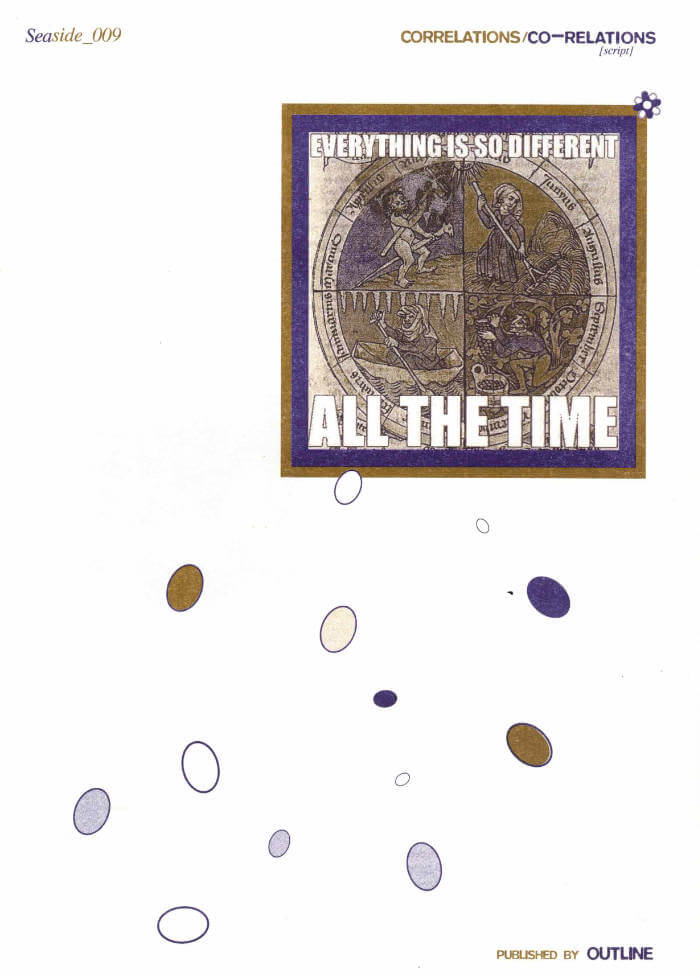
Seaside_009: Correlations/co-relations
Seaside_009: Correlations/co-relations: was read and listened to collectively during a gathering on 13 October 2023 during BYOB Art Book Fair at Enter Enter in Amsterdam. This loosely connected patchwork of bootlegged texts and collected sounds all deal with notions of the archive and the remix in some way or another. Together they form a soft proposal for a publishing practice based around dubbing, multivocality and “speaking nearby”.

Full Auto 3: The Title of This Work is to be Sketched
Part documentation, part drawing tool, fa3 is a publication that contains the work done through full auto foundry, a workshop-based type foundry that explores how processes of automation and tool-assisted sketching can influence the design of typefaces.
Using analogue tools, participants of the workshops are encouraged to draw letterforms without thinking too much about what the letter should be. Absent-minded drawing and doodling replace thought-out design, leading to alphabets quickly (and sometimes slowly) emerging through the repetition of mark-making. The quality, in a traditional sense, of these letterforms becomes less important than the quantity of them and the marks that were drawn to produce them, this often leads to oddly inconsistent but exciting typefaces. Once the sketches that the participants produce are finished, they are scanned and go through a process of automated digitisation. Each typeface that is produced is available with an open-source license, free to download and free to manipulate.
fa3 is a publication that is both a collection of all the drawing tools that have been designed/used in workshops and a drawing tool itself. Using these pages as a traceable surface the reader/drawer can combine forms and patterns together with the goal of creating letters.

Survival Guide for Self Publishers in The Netherlands
Survival Manual for Self-publishers in NL is a zine that consolidates essential knowledge for thriving as a self-publisher. With a focus on practicality, this comprehensive guide brings together previously scattered and opaque information from the self-publishing realm.
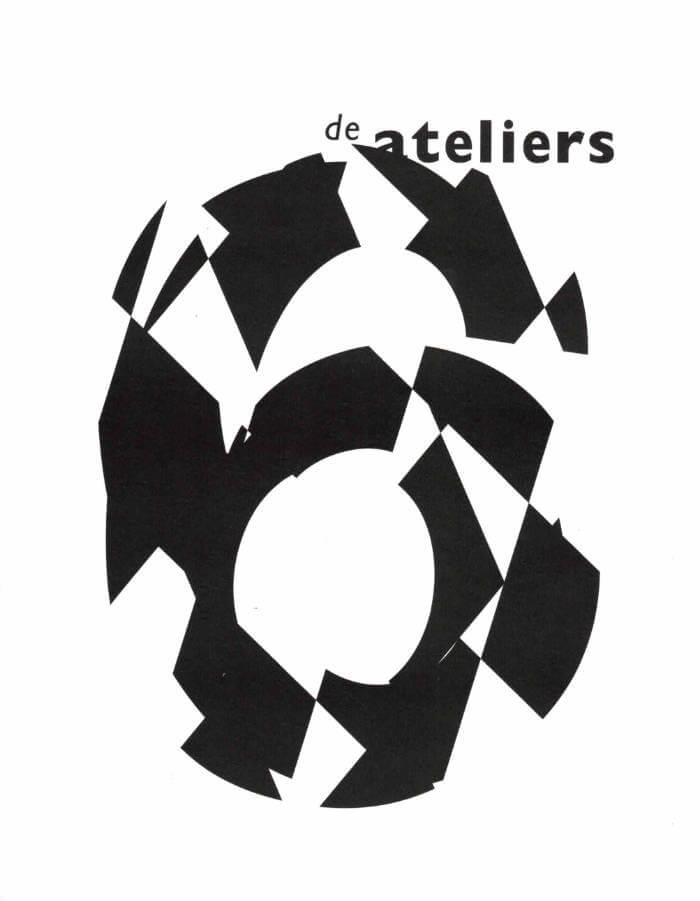
De Ateliers 1963 - 2023
The turbulent history of De Ateliers is one of passionate ideals and fierce rivalry. The essay, based on interviews are richly illustrated with never before published photos and archive materials.
Design: Sabo Day

The Lowell Re:Offering - Conjuring the Ghosts of Lowell
A poetic script, an apocalyptic newspaper, and a syntax of intersected historical narratives. An investigation of an archive of writings previously published in The Lowell Offering, a periodical issued between 1840-1845 by women factory workers in Lowell, Massachusetts.
Design by Daria Kiseleva

Errant Journal 6: Debt
Errant Journal No. 6 takes up the topic of debt in order to challenge the idea that it is something rational, natural or inevitable.
The contributions in the issue address the ways in which debt and its language hold power over us and organize obedience; from its role in geopolitics to its associations with shame and guilt through moral and religious connotations. Together they reveal how the personal is always connected to the structural. Crucially, the issue also features contributions that address ways of thinking about debt outside Western/neoliberal hegemony and introduce instances of resistance to the violence and inequality inherent to debt. We’ve made additional space in this issue to address the intensified struggle for Palestinian liberation and its relations to debt/guilt and finance.
Contributors: Ian Beattie, W.E.B. Du Bois, Sultan Doughan, Toon Fibbe, Ibrahim Kombarji, Levi Masuli, Jamie McGhee, Kristina Millona, Bahar Noorizadeh, Falke Pisano, Taring Padi, Dalia Wahdan

Dreams of a Dreamless Night
The publication is the first institutional monograph on the multimedia practice of artist and director Ali Cherri. It aims to highlight the constellation of ideas, themes, and formal concerns running through his most recent, highly significant projects.
Edited by Alessandro Rabottini and Leonardo Bigazzi, with Bianca Stoppani, this book provides an overview of the artist's output over the past three years, teasing out both new strands for interpretation and formal links between his films, videos, sculptures, drawings, and installations.
Texts by: Cecilia Alemani, Erika Balsom, Étienne Bernard, Leonardo Bigazzi, Ali Cherri, Lorenzo Giusti, Stefanie Hessler, Priyesh Mistry, Alessandro Rabottini, Stefan Tarnowski.
Video and visual artist Ali Cherri (born 1976 in Beirut, lives and works in Paris and Beirut) received a BA in graphic design from the American University in Beirut in 2000, and an MA in performing arts from DasArts, Amsterdam, in 2005. His current project looks at the place of the archaeological object in the construction of historical narratives.